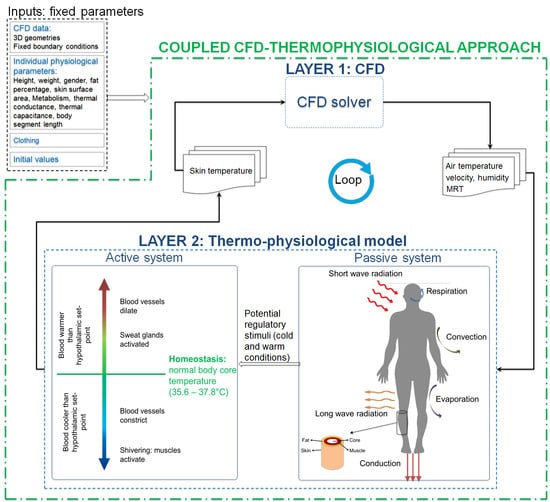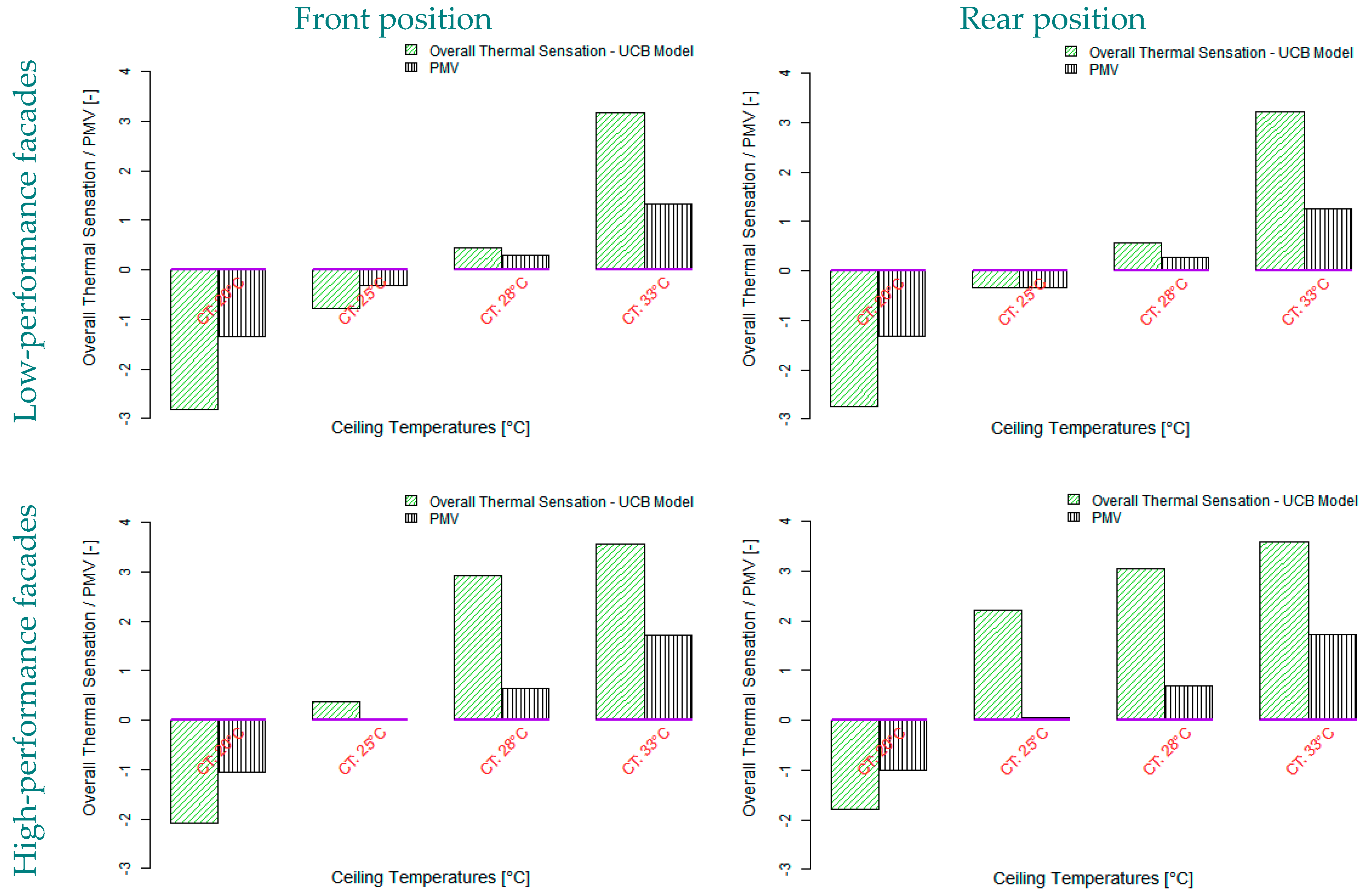Evaluation of Radiant Heating Ceiling Based on Energy and Thermal Comfort Criteria, Part II: A Numerical Study
Abstract
1. Introduction
2. Materials and Methods
2.1. Transient Energy Simulation
2.1.1. Heating and Renovation Scenarios
2.1.2. TRNSYS Simulation Model
2.2. CFD–Thermoregulation Simulation
Coupled CFD–Thermoregulation Model
3. Data Validation
4. Results and Discussion
4.1. Transient Energy Simulation
4.1.1. Room Conditions Corresponding to the Scenarios
4.1.2. Heat Losses and Energy Consumption
4.2. Coupled CFD–Thermoregulation Simulation-Based Thermal Comfort
4.2.1. CFD Analyses
4.2.2. Thermal Sensation and Comfort Analyses
4.2.3. Thermal Sensation Asymmetry Analyses
- The east wall (right wall and façade) and the west wall have about similar inner surface temperatures, and its difference is negligible for the high-performance façade. As discussed in Section 4.2.1, the large surface of the warm ceiling evenly heats surfaces through the radiation and consequently, the warm room surfaces heat the room air volume. The direct radiation from all warm surfaces and the adjacent warm air can increase the surface temperature façade even its thermal insulation is relatively poor;
- The winter clothing insulation reduces the efficiency of the radiation heat exchange between the body parts and the room surfaces. The influence of slightly different temperatures of opposite surfaces on the thermal status of the insulated body parts is negligible.
- The unclothed right and left hands are at an equal distance with respect to the right and left walls. Additionally, the thermal status of nude hands is mainly influenced by the relatively cool window and north façade. Therefore, the temperature asymmetry of the right and left walls has a negligible effect on the thermal sensation asymmetry of the hands.
5. Summary
- Highlights:
- The results of this study indicate that the radiant heating ceiling creates negligible radiant temperature asymmetry, particularly for the buildings that have high-performance facades. This is due to the room surfaces receiving direct radiative heat from the warm ceiling; thus, their temperatures increase almost evenly unless the energy performance of the envelope or outside air temperature is extremely low. The room surfaces with roughly equal temperatures result in minimum radiant asymmetry, operative temperature stratification, and maximum uniform conditions.
- It is worth mentioning here that the results of this study suggest that ceiling temperatures as low as 20–25 °C in renovated buildings and 25–28 °C in a building with low-performance facades can provide optimal thermal sensations at most body parts, particularly at extremities.
- Fanger, ASHRAE-55, and CIBSE Guide-A [3,7,28] suggested that the maximum radiant temperature asymmetry of 4 K corresponds to 5% dissatisfied persons for overhead radiant systems. However, the results imply that in reality, relatively uniform room air/operative temperatures corresponding to each ceiling temperature have a stronger effect on the overall and local thermal sensations than radiant temperature asymmetry.
- Importantly, the comparisons shown in Appendix A prove that the PMV comfort model is not a suitable model for the evaluation of radiant heating ceiling systems based on thermal comfort criteria (especially if occupants have winter clothes), even if the air and operative temperature distributions near an occupant are uniform. It is because the PMV model calculates the heat balance between the human and its environment at a single node. However, as the studies by Zhang et al. [10,26] showed, the overall thermal sensation depends on local thermal sensation values at various body parts. For the UCB model, the effect of only one/few warmest or coolest part(s) (e.g., warm head or cold feet) may have a dominant effect (depending on weighting factor, C1 [26]) on the overall thermal sensation.
- For a controlled operation of the radiant ceiling, the variation of the ceiling temperatures is strong for relatively high supply water temperatures and particularly for buildings with low-performance materials. In contrast, the small ceiling temperature variation can be seen for renovated buildings with the ideal supply water temperatures between 28–45 °C. The variation is minimum for the supply water temperature of 38 °C, which is a realizable supply temperature from a low-temperature heat pump.
- Unexpectedly, at some operative temperatures (28 °C and 33 °C) the chest and back feel cooler compared to the lower operative temperatures (25 °C). The reasons are discussed in Section 4.2.2.
- Lowlights:
- Due to negligible radiant temperature asymmetry and the dominant effect of uniform air temperatures, the thermal sensation asymmetries between the right and left body parts or chest and back are negligible.
- While the highest comfort condition is reported at the head, chest, back, and thigh, the feet and hands are the least comfortable at these temperatures. These results are broadly consistent with the experimental results obtained in the LOBSTER test facility [1].
- Simulation results show clear differences between the local thermal sensations as well as comfort in approximately equal operative temperatures. For instance, although the operative temperatures at the thighs and hands are about the same, hands feel cooler than thighs. The differences can be traced to a different level of cloth insulation on each body part, different skin temperatures, different local thermoregulation, and thus the corresponding equations at each body part derived by Zhang [10].
- In comparison with the reference building, in a building with high performance, the operative temperature maintains within the comfort range for a longer time with fewer fluctuations.
6. Limitations and Future Challenges
Author Contributions
Funding
Acknowledgments
Conflicts of Interest
Appendix A

References
- Safizadeh, M.R.; Schweiker, M.; Wagner, A. Experimental Evaluation of Radiant Heating Ceiling Systems Based on Thermal Comfort Criteria. Energies 2018, 11, 2932. [Google Scholar] [CrossRef]
- Rhee, K.-N.; Kim, K.W. A 50 year review of basic and applied research in radiant heating and cooling systems for the built environment. Build. Environ. 2015, 91, 166–190. [Google Scholar] [CrossRef]
- Fanger, P.O.; Banhidi, L.; Olesen, B.W.; Langkilde, G. Comfort limits for heated ceilings. ASHRAE Trans. 1980, 86, 141–156. [Google Scholar]
- Atmaca, I.; Kaynakli, O.; Yigit, A. Effects of radiant temperature on thermal comfort. Build. Environ. 2007, 42, 3210–3220. [Google Scholar] [CrossRef]
- Huizenga, C.; Zhang, H.; Mattelaer, P.; Yu, T.; Arens, E.; Lyons, P. Window Performance for Human Thermal Comfort; Center for the Built Environment, University of California, Berkeley: Berkeley, CA, USA, 2006. [Google Scholar]
- Rowe, D. Effect on Thermal Comfort of Radiant Heat Exchange Near Single Glazed Windows. Archit. Sci. Rev. 2003, 46, 29–35. [Google Scholar] [CrossRef]
- ASHRAE-55. ANSI/ASHRAE Standard 55-2017: Thermal Environmental Conditions for Human Occupancy; ASHRAE: Atlanta, GA, USA, 2017. [Google Scholar]
- Chrenko, F.A. Heated Ceilings and Comfort. J. Inst. Heat. Vent. Eng. 1953, 20, 375–396. [Google Scholar]
- Heise, Z.; Huafen, H. A field study of occupant thermal comfort with radiant ceiling panel systems. ASHRAE Trans. 2013, 199, 1–8. [Google Scholar]
- Zhang, H. Human Thermal Sensation and Comfort in Transient and Non-Uniform Thermal Environments; University of California, Berkeley: Berkeley, CA, USA, 2003. [Google Scholar]
- Wang, Z.H.; Zhang, H.; Arens, E.; Lehrer, D.; Huizenga, C.; Yu, T.; Hoffman, S. Modeling thermal comfort with radiant floors and ceilings. In Proceedings of the 4th International Building Physics Conference, Istanbul, Turkey, 15–18 June 2009; Volume 94, pp. 9–10. [Google Scholar]
- Wang, D.; Zhang, H.; Arens, E.; Huizenga, C. Observations of upper-extremity skin temperature and corresponding overall-body thermal sensations and comfort. Build. Environ. 2007, 42, 3933–3943. [Google Scholar] [CrossRef]
- Tanabe, S.I.; Kobayashi, K.; Nakano, J.; Ozeki, Y.; Konishi, M. Evaluation of thermal comfort using combined multi-node thermoregulation (65MN) and radiation models and computational fluid dynamics (CFD). Energy Build. 2002, 34, 637–646. [Google Scholar] [CrossRef]
- Karacavus, B.; Aydin, K. Numerical investigation of general and local thermal comfort of an office equipped with radiant panels. Indoor Built Environ. 2019, 28, 806–824. [Google Scholar] [CrossRef]
- Han, C. Influence of laying position of capillary planar radiant air conditioner on thermal comfort. AIP Conf. Proc. 2019, 2106, 020008. [Google Scholar] [CrossRef]
- Alfano, F.R.D.A.; Dell’Isola, M.; Palella, B.I.; Riccio, G.; Russi, A. On the measurement of the mean radiant temperature and its influence on the indoor thermal environment assessment. Build. Environ. 2013, 63, 79–88. [Google Scholar] [CrossRef]
- Alfano, F.R.D.A.; Palella, B.I.; Riccio, G. Notes on the Calculation of the PMV Index by Means of Apps. Energy Procedia 2016, 101, 249–256. [Google Scholar] [CrossRef]
- Loga, T.; Stein, B.; Diefenbach, N.; Born, R. Deutsche Wohngebäudetypologie Beispielhafte Maßnahmen zur Verbesserung der Energieeffizienz von Typischen Wohngebäuden; Institut Wohnen und Umwelt GmbH (IWU): Darmstadt, Germany, 2015; p. 18. [Google Scholar]
- Zottl, A.; Nordman, R.; Miara, M. Benchmarking method of seasonal performance. IEE Proj. SEPEMO-Build 2012. [Google Scholar]
- Ornth, W. Bekanntmachung der Regeln zur Datenaufnahme und Datenverwendung im Wohngebäudebestand; Bundesministerium für Verkehr Bau und Stadtentwicklung: Germany, 2009; p. 23. [Google Scholar]
- Sabatino, R. A Coupled CFD and Thermoregulation Model to Evaluate Thermal Comfort Criteria in Asymmetrical Thermal Environments Created by Ceiling Heating Systems; Karlsruhe Institute of Technology (KIT): Karlsruhe, Germany, 2018. [Google Scholar]
- Wagner, A.; O’Brien, W.; Dong, B. Exploring Occupant Behavior in Buildings: Methods and Challenges; Wagner, A., O’Brien, W., Dong, B., Eds.; Springer International Publishing: Berlin/Heidelberg, Germany, 2017. [Google Scholar]
- Li, R.; Yoshidomi, T.; Ooka, R.; Olesen, B.W. Field evaluation of performance of radiant heating/cooling ceiling panel system. Energy Build. 2015, 86, 58–65. [Google Scholar] [CrossRef]
- Voelker, C.; Alsaad, H. Simulating the human body’s microclimate using automatic coupling of CFD and an advanced thermoregulation model. Indoor Air 2018, 28, 415–425. [Google Scholar] [CrossRef] [PubMed]
- Fiala, D. Dynamic Simulation of Human Heat Transfer and Thermal Comfort; De Montfort University: Leicester, UK, 1998. [Google Scholar]
- Zhang, H.; Arens, E.; Huizenga, C.; Han, T. Thermal sensation and comfort models for non-uniform and transient environments: Part I: Local sensation of individual body parts. Build. Environ. 2010, 45, 389–398. [Google Scholar] [CrossRef]
- Hensel, H. Thermal Sensations and Thermoreceptors in Man; Springfield: Thomas, IL, USA, 1982; ISBN 0398046980. [Google Scholar]
- Nicol, F.; Nikolopoulou, M.; Humphreys, M.; Liddament, M.; Loe, D.; Shelton, J.; Wilson, M.; Yao, R. Environmental criteria for design. In GVA/15 CIBSE Guide A Environmental Des. 2015; CIBSE: London, UK, 2016. [Google Scholar]
- Safizadeh, M.R.; Wagner, A. Evaluation of Radiant Ceiling Heating Systems for Renovated Buildings based on Thermal Comfort Criteria. In Proceedings of the 10th Windsor Conference: Rethinking comfort, Windsor, UK, 12–15 April 2018; pp. 128–142. [Google Scholar]

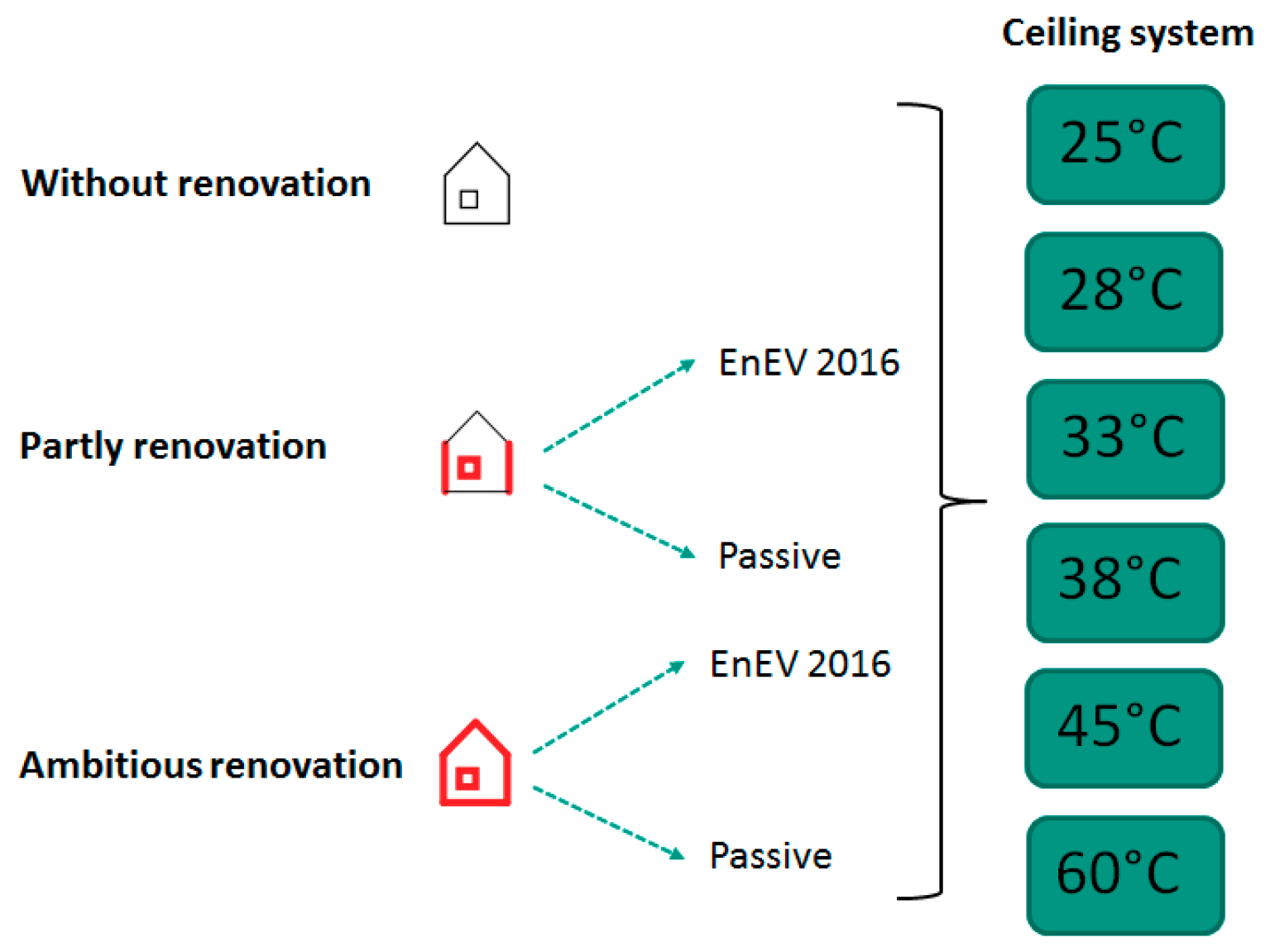
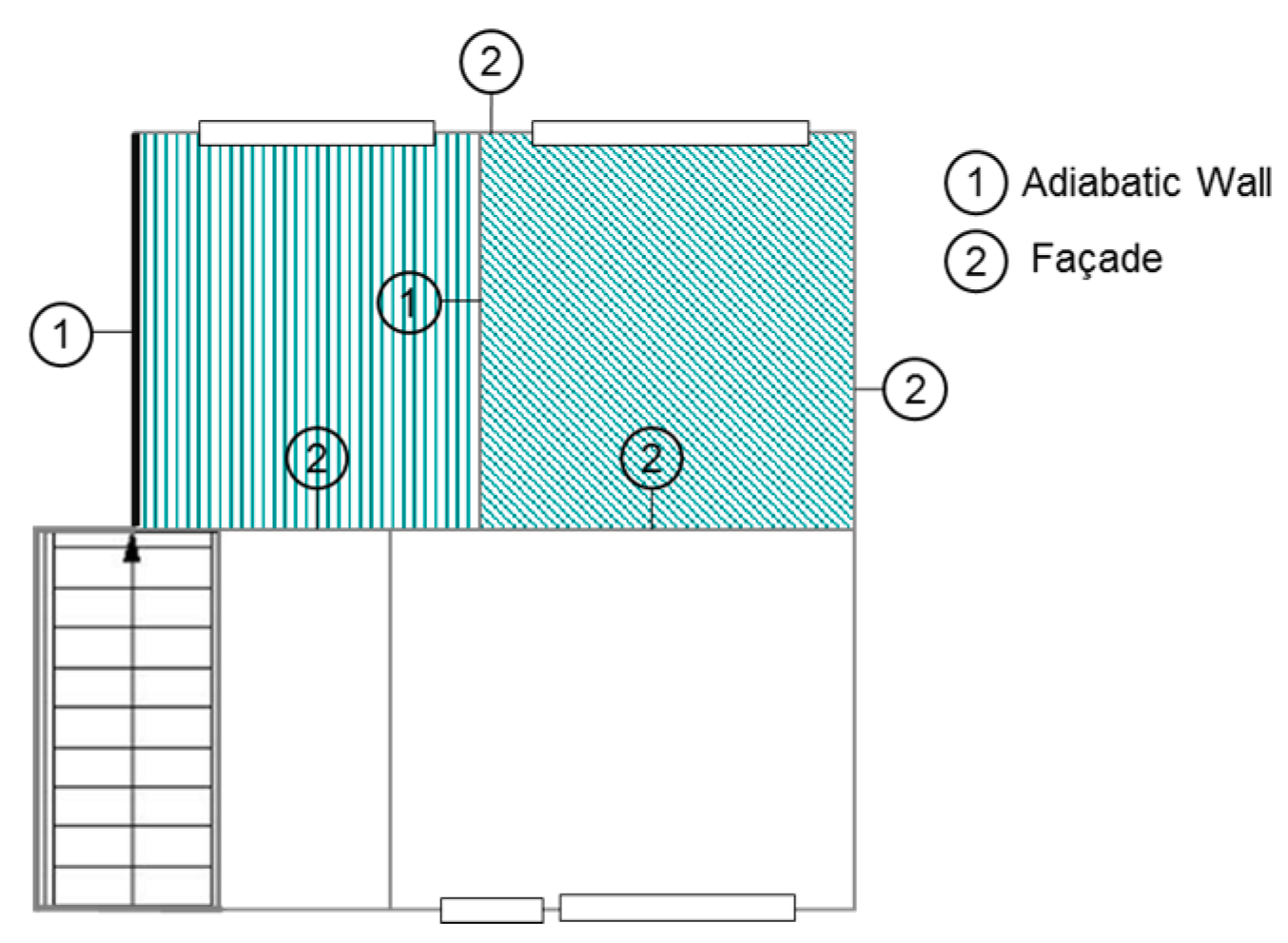
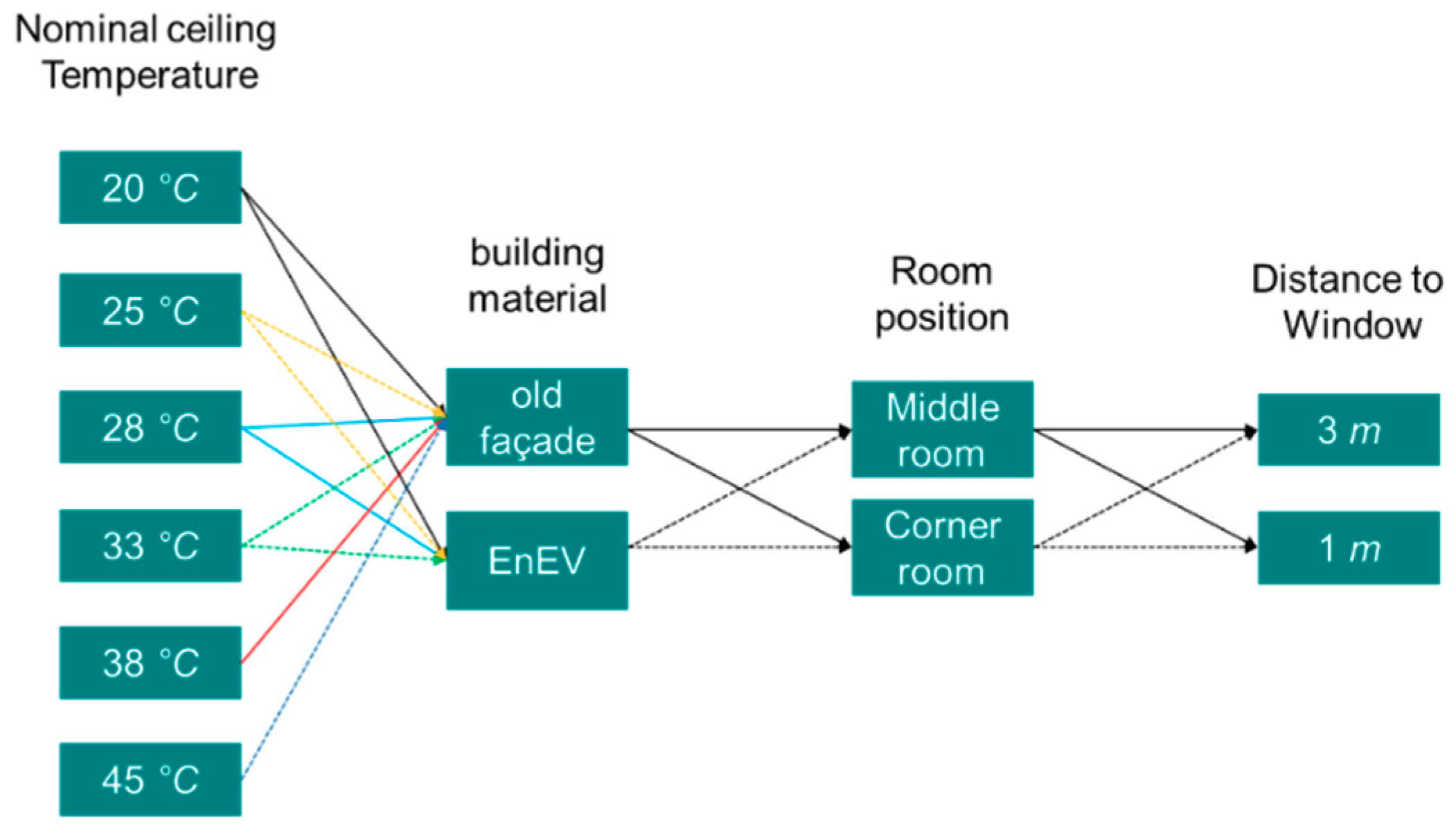

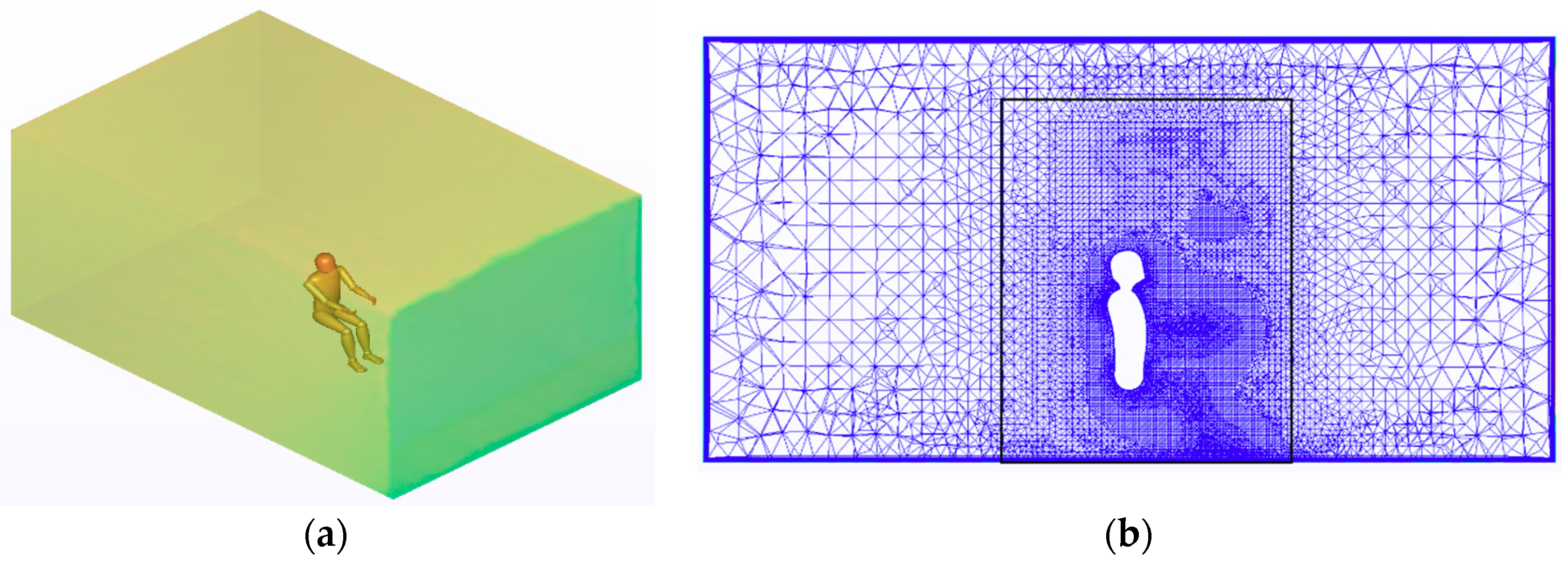
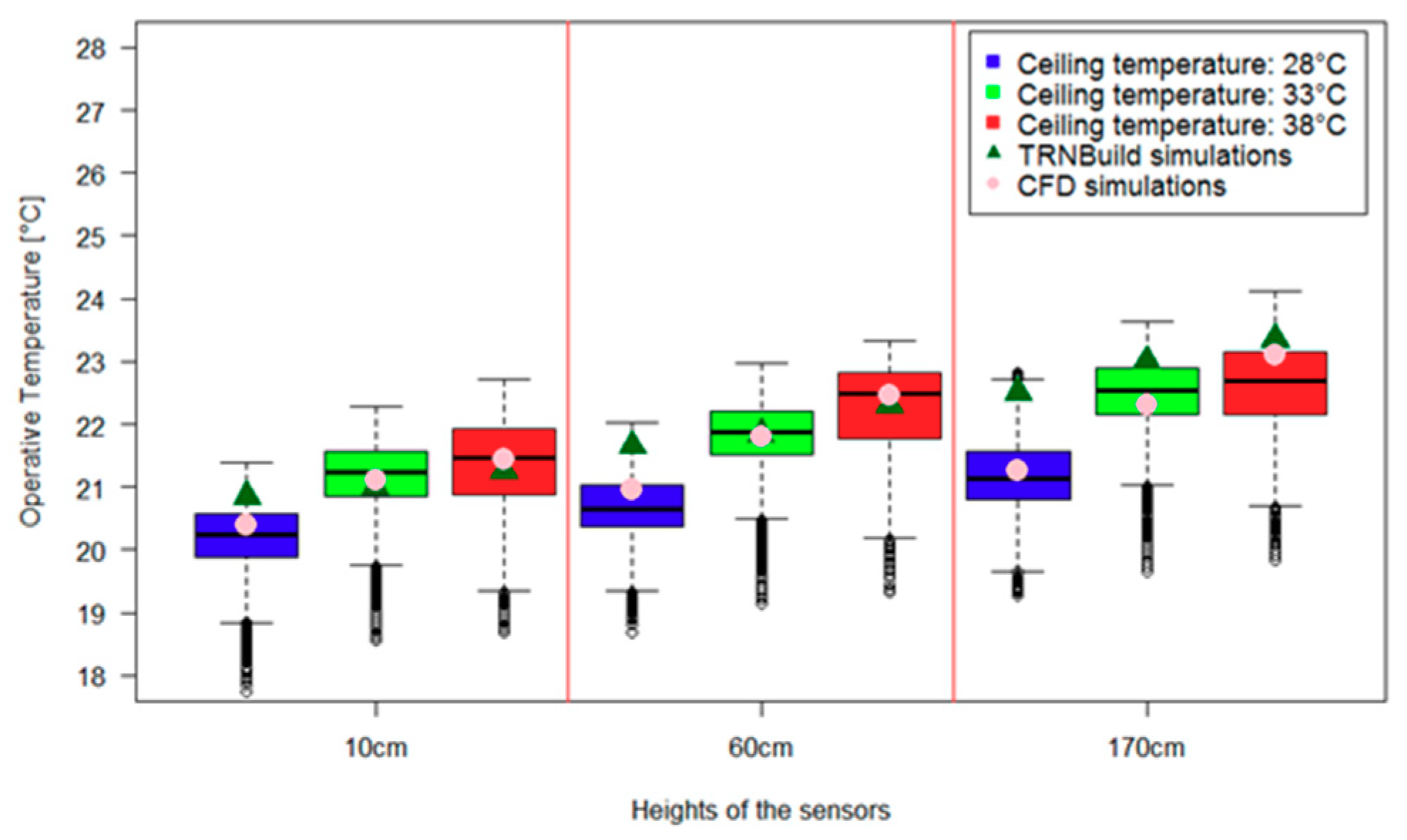
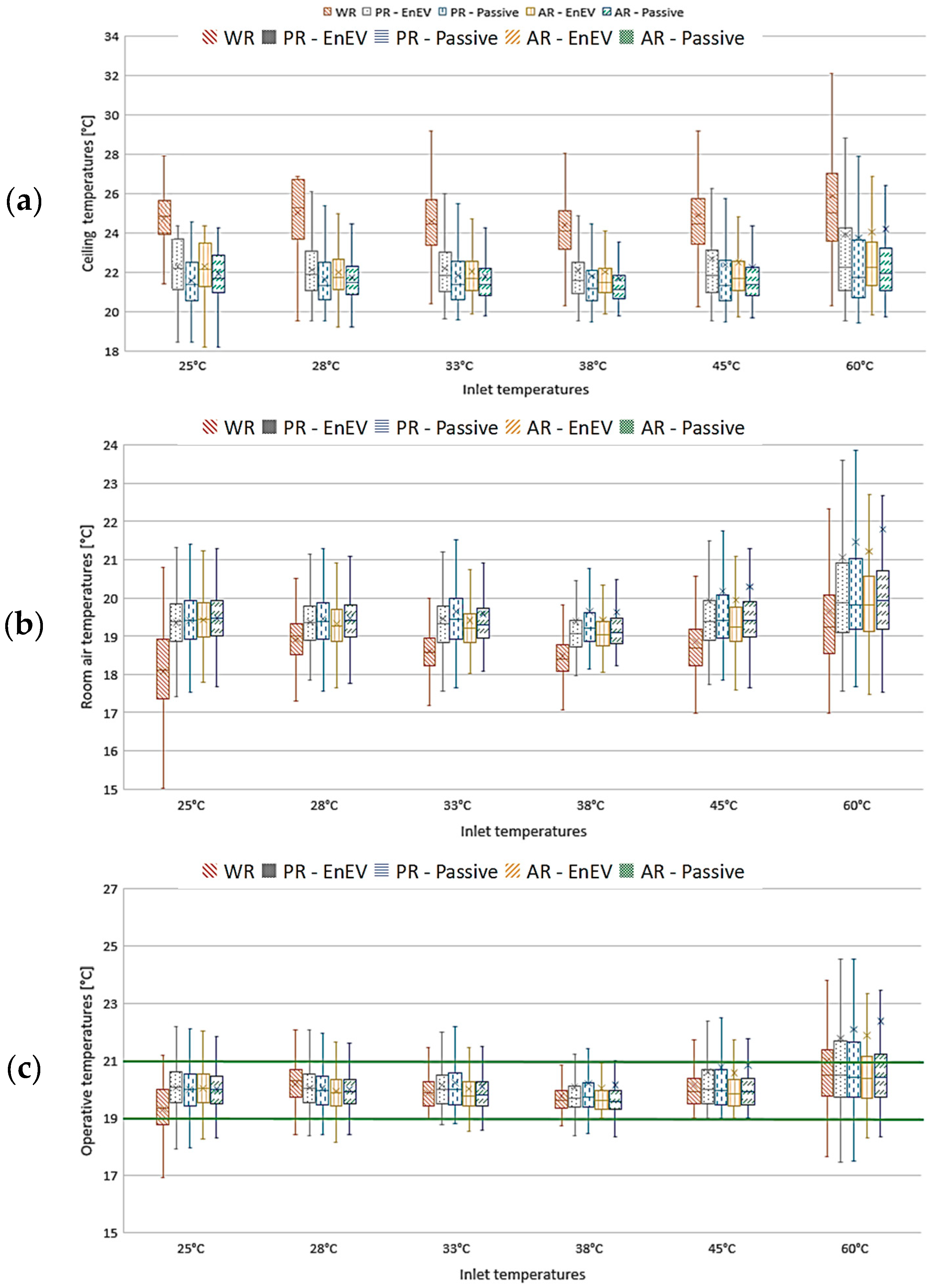
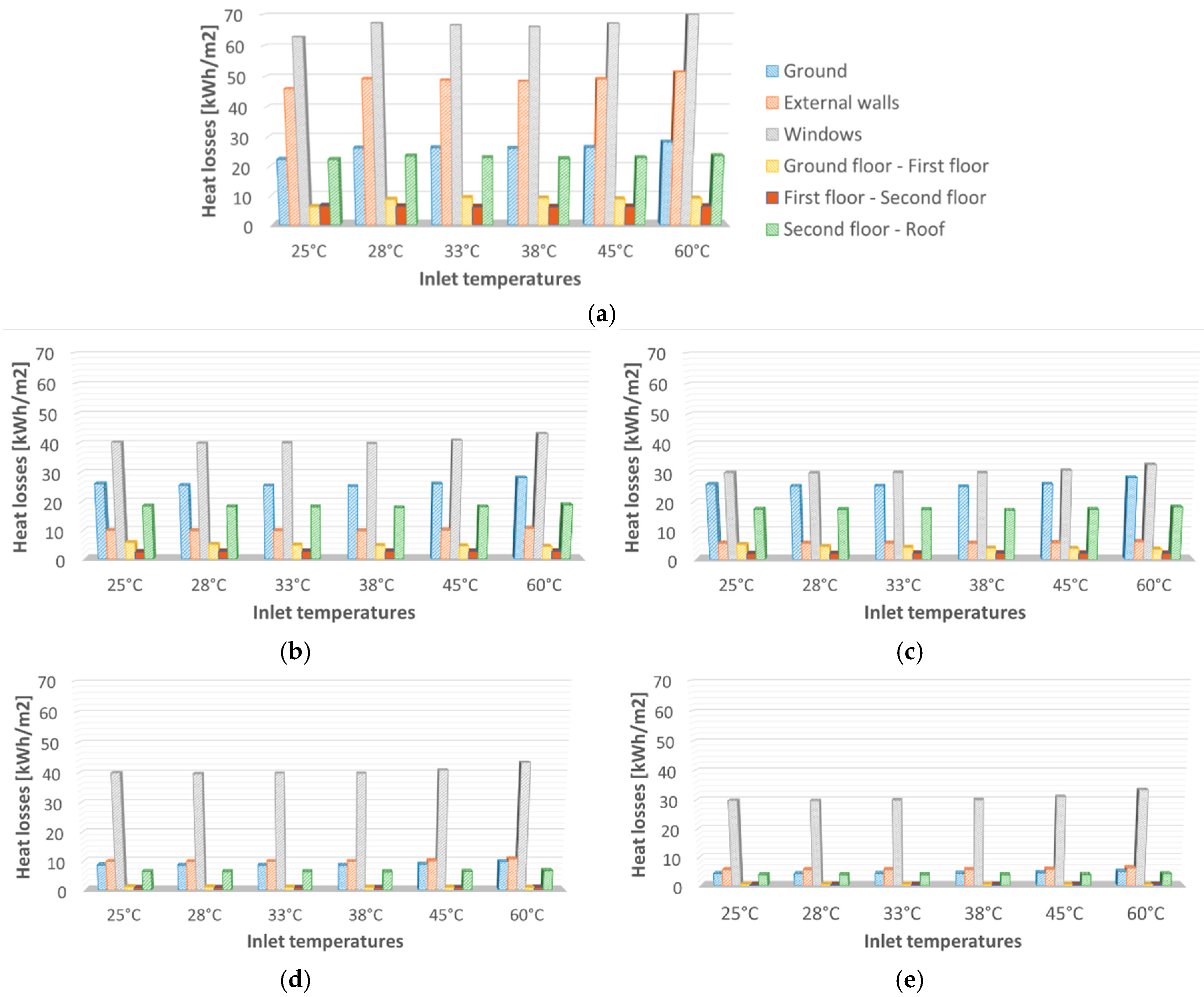
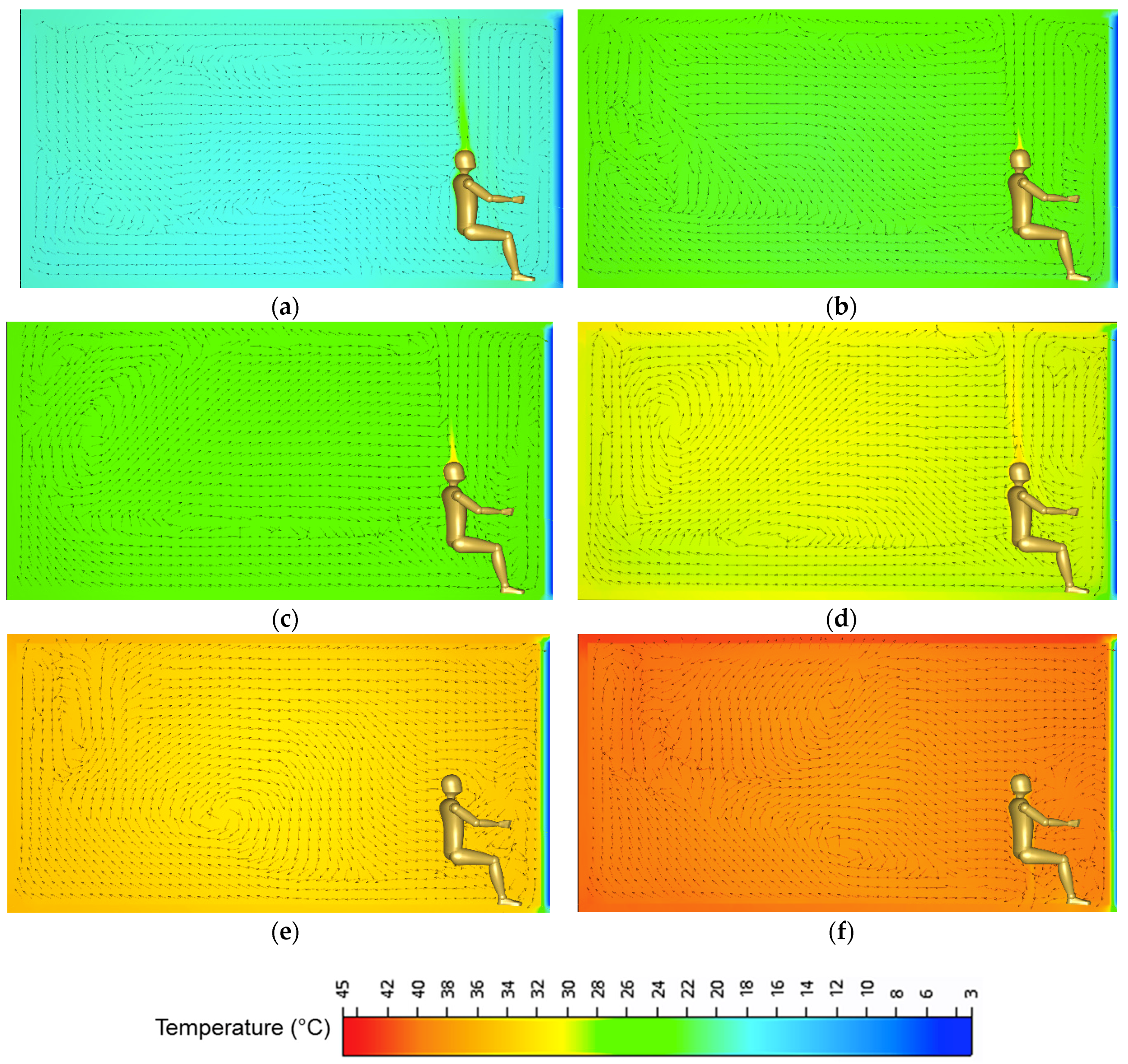
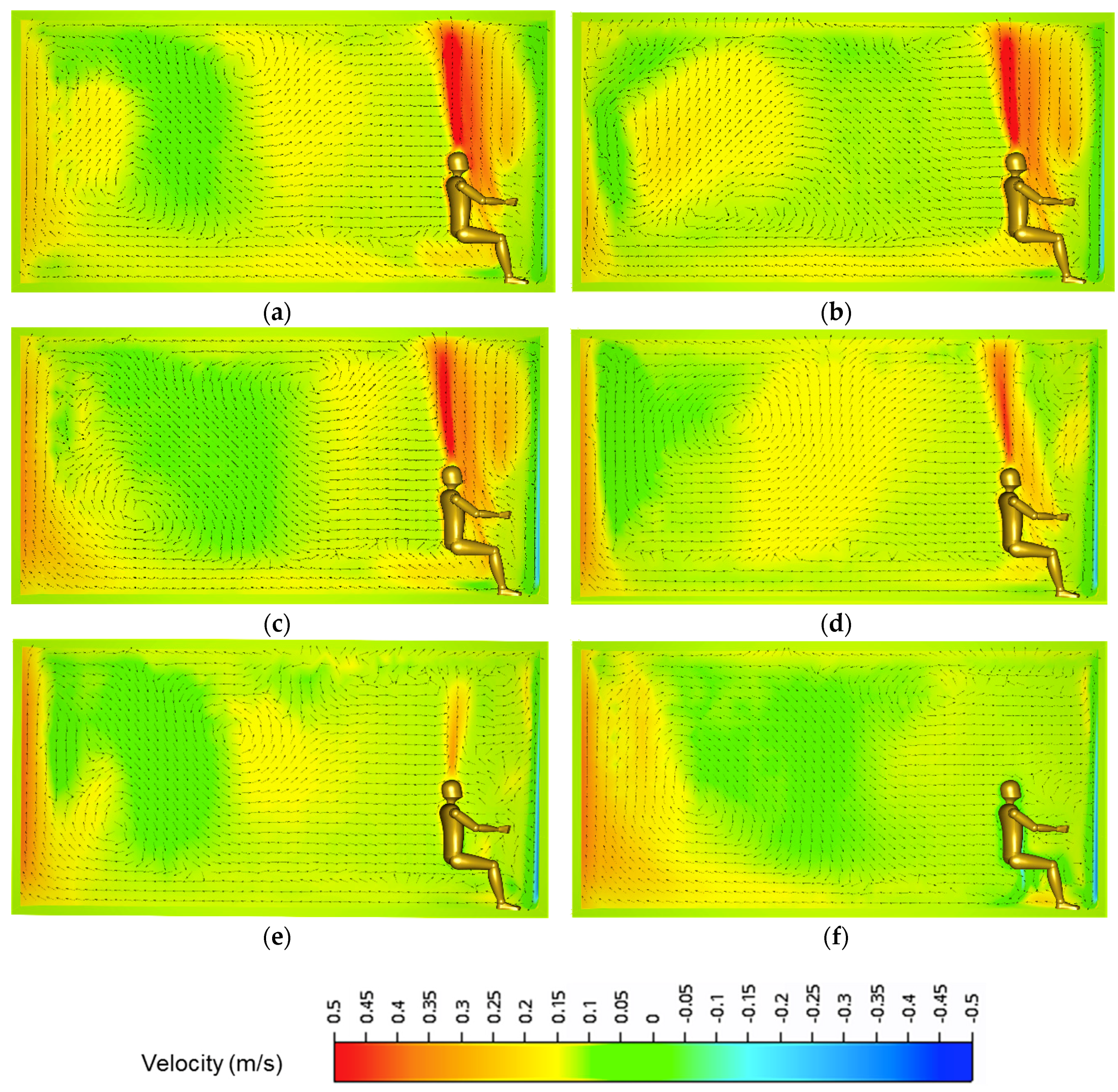
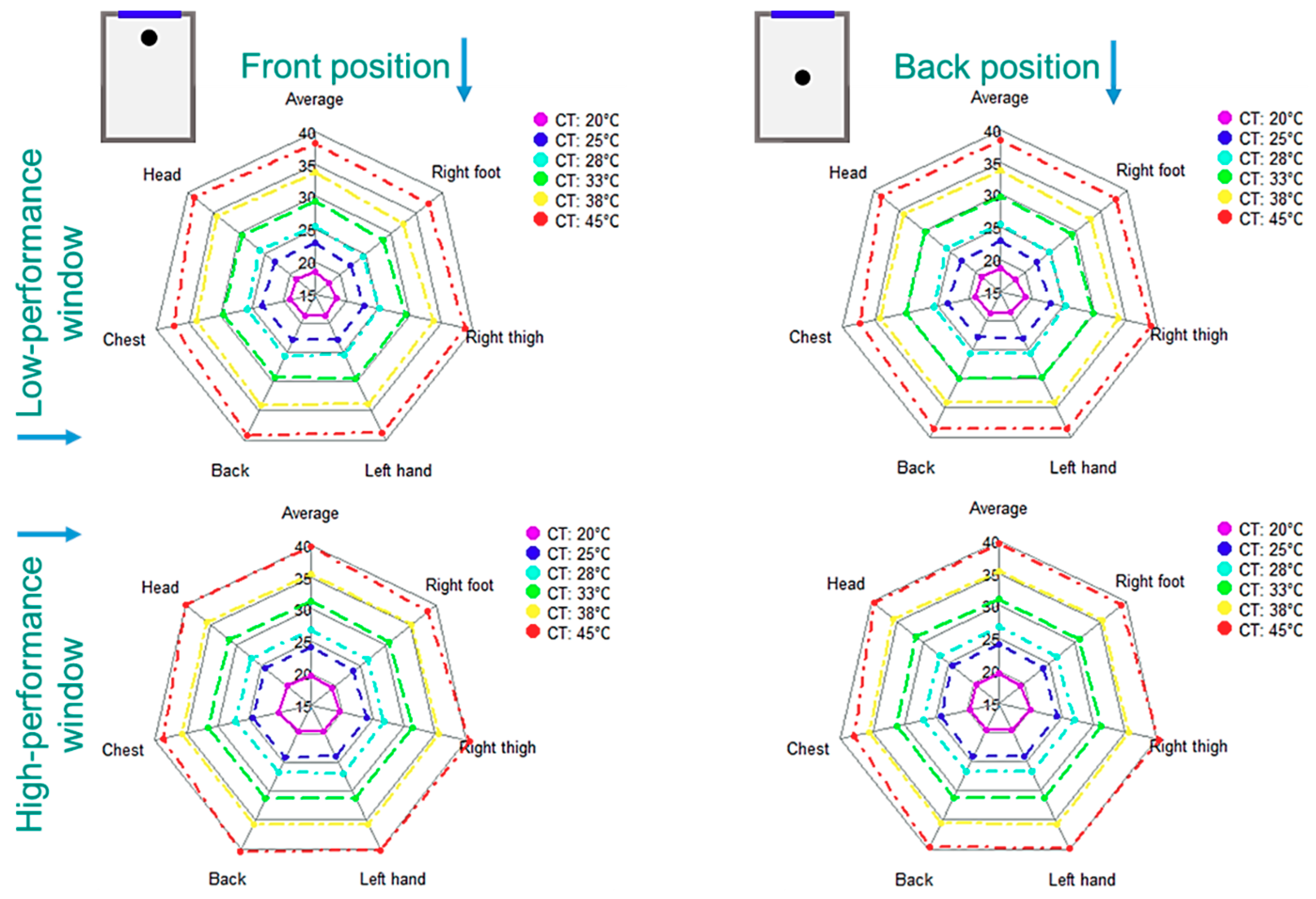
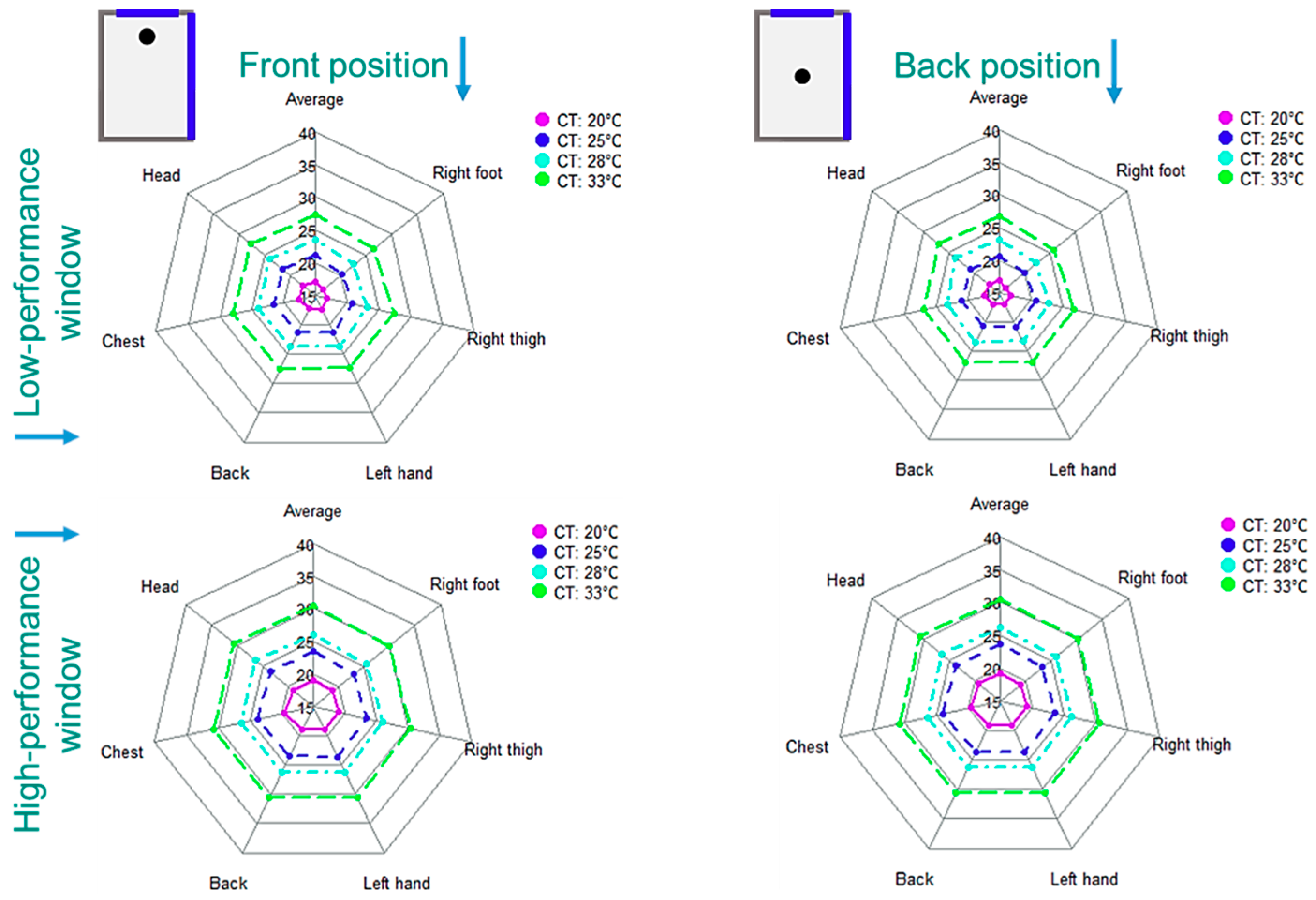
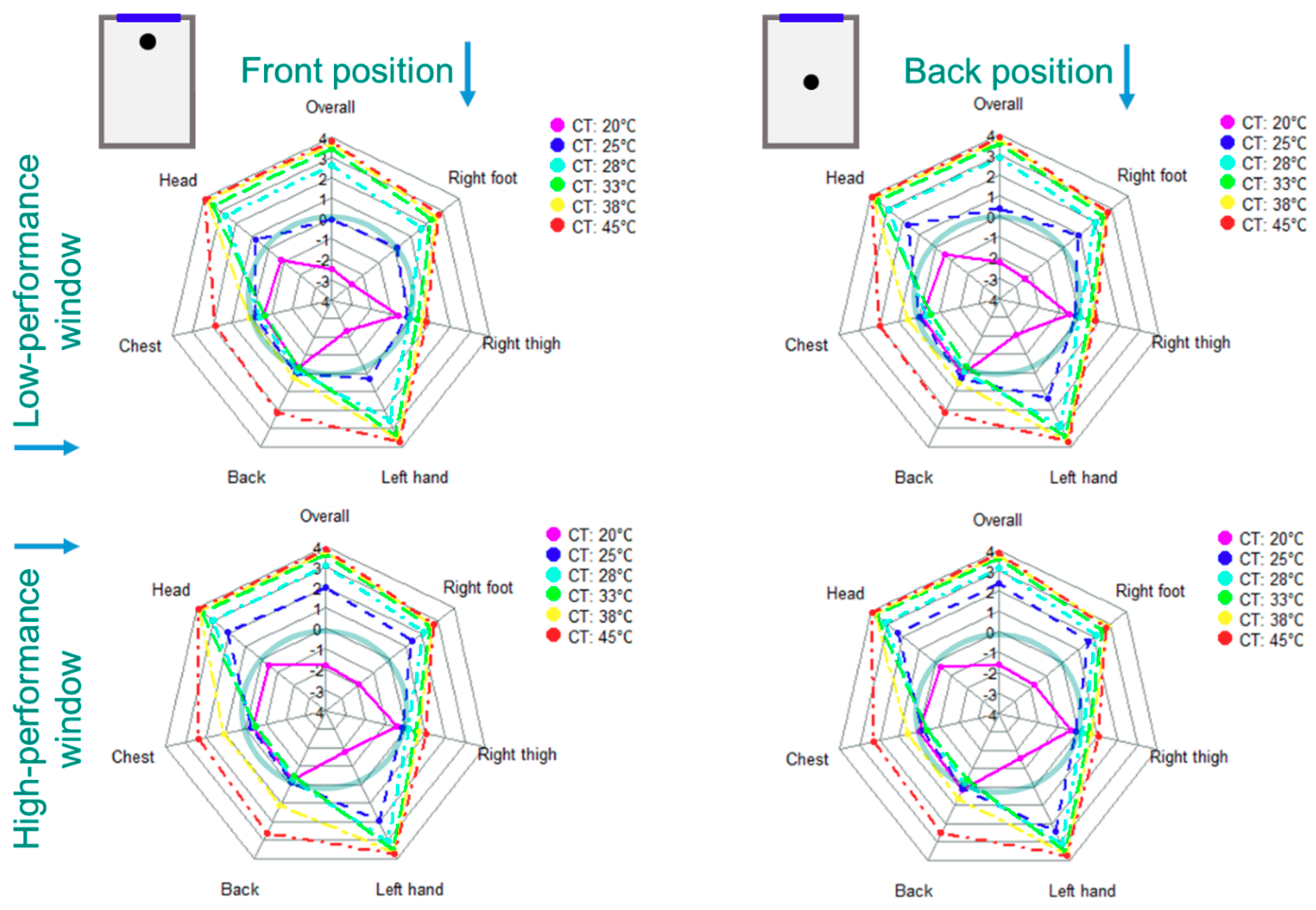
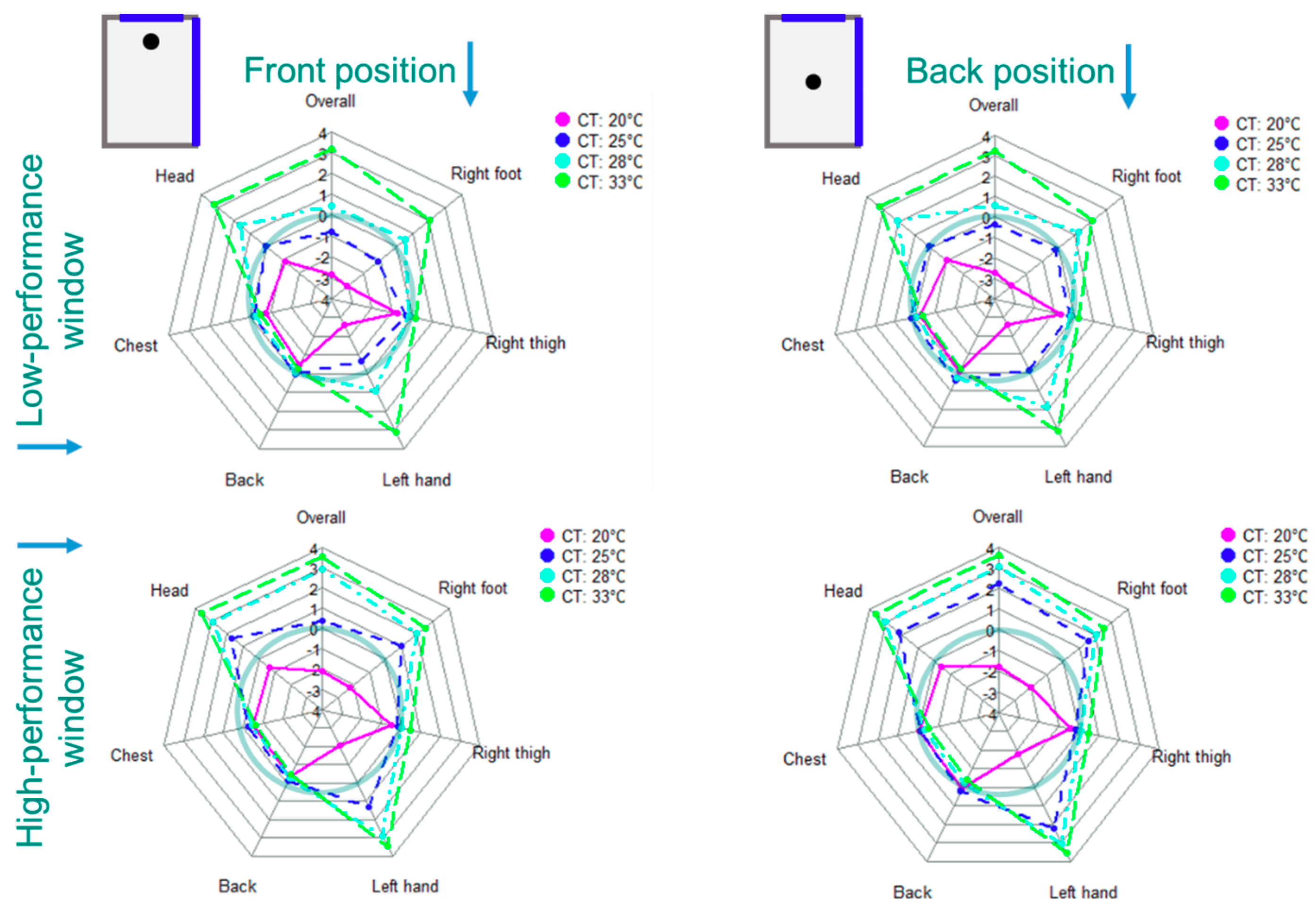
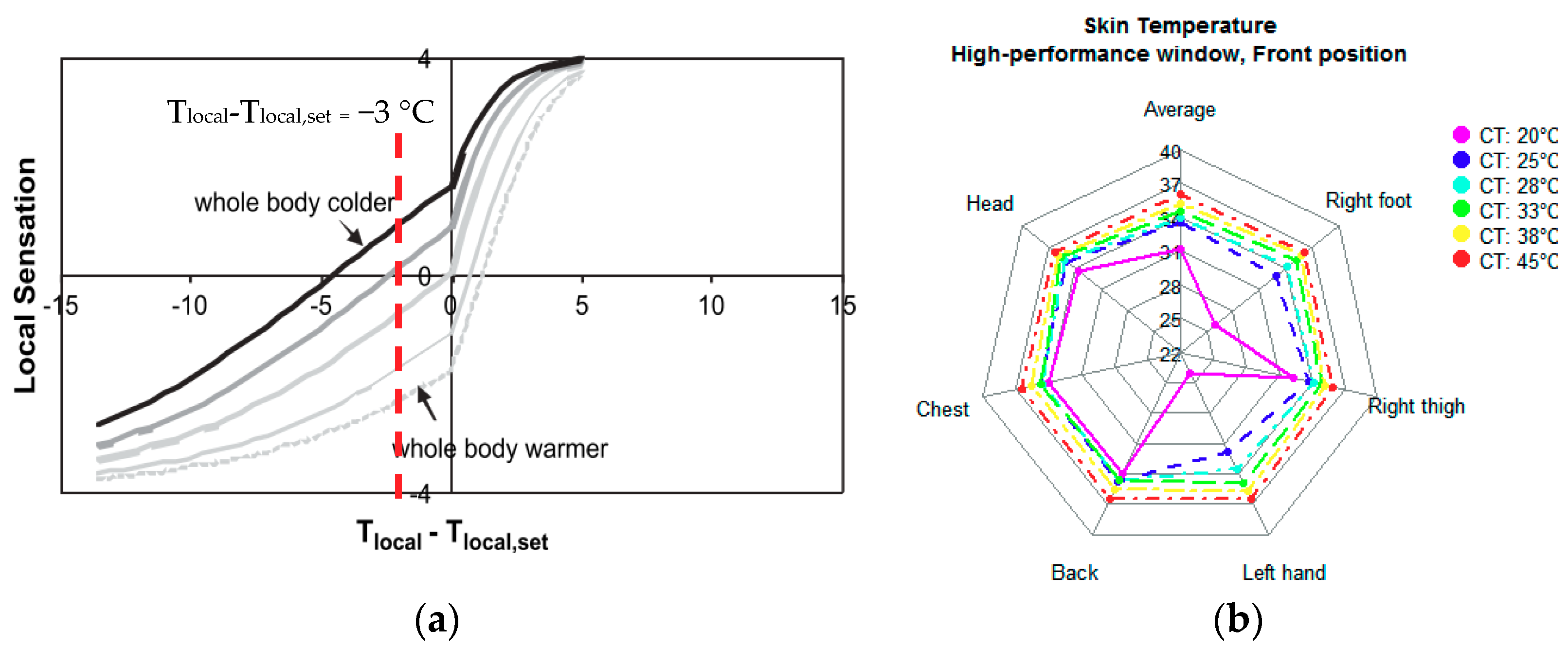
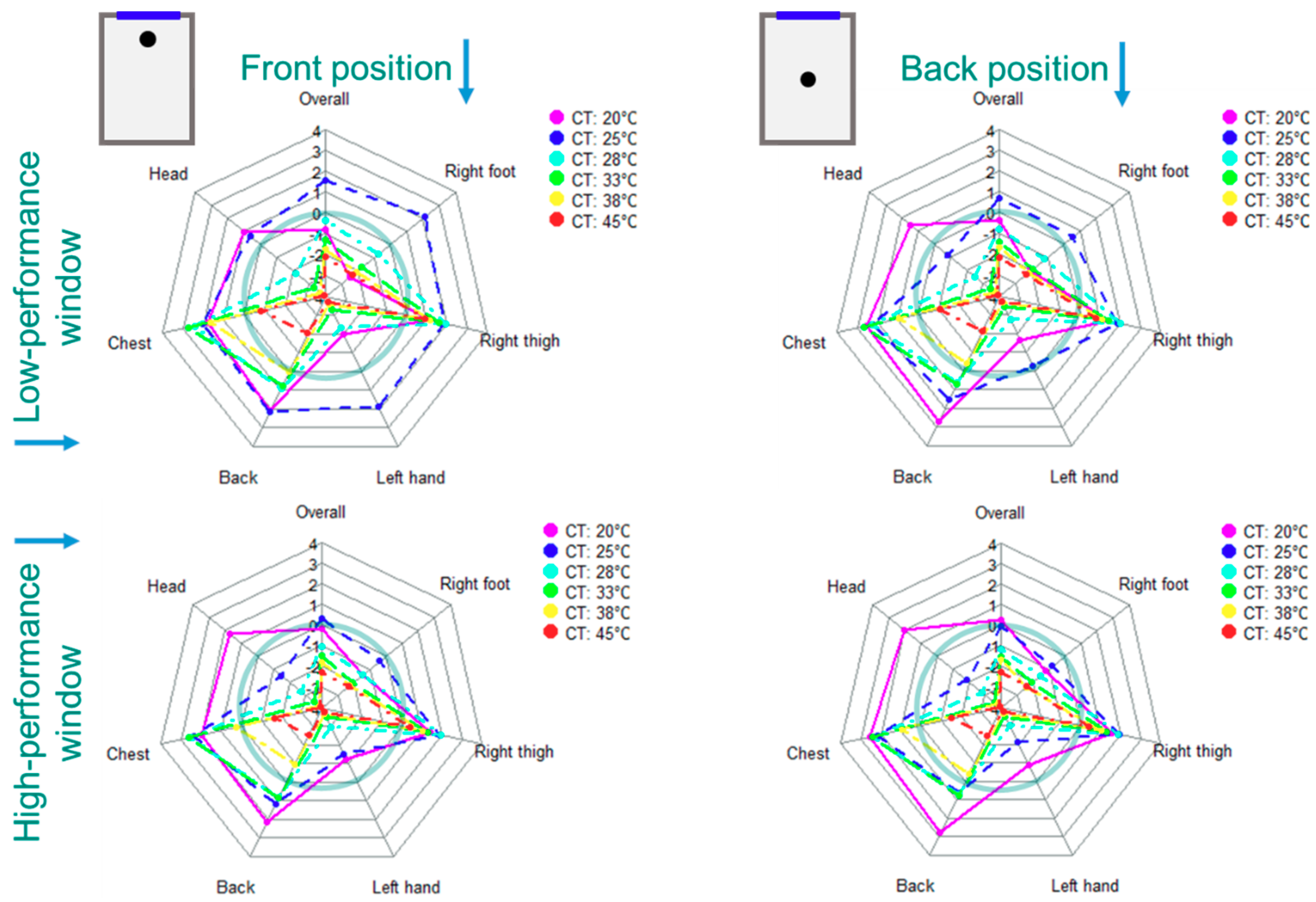
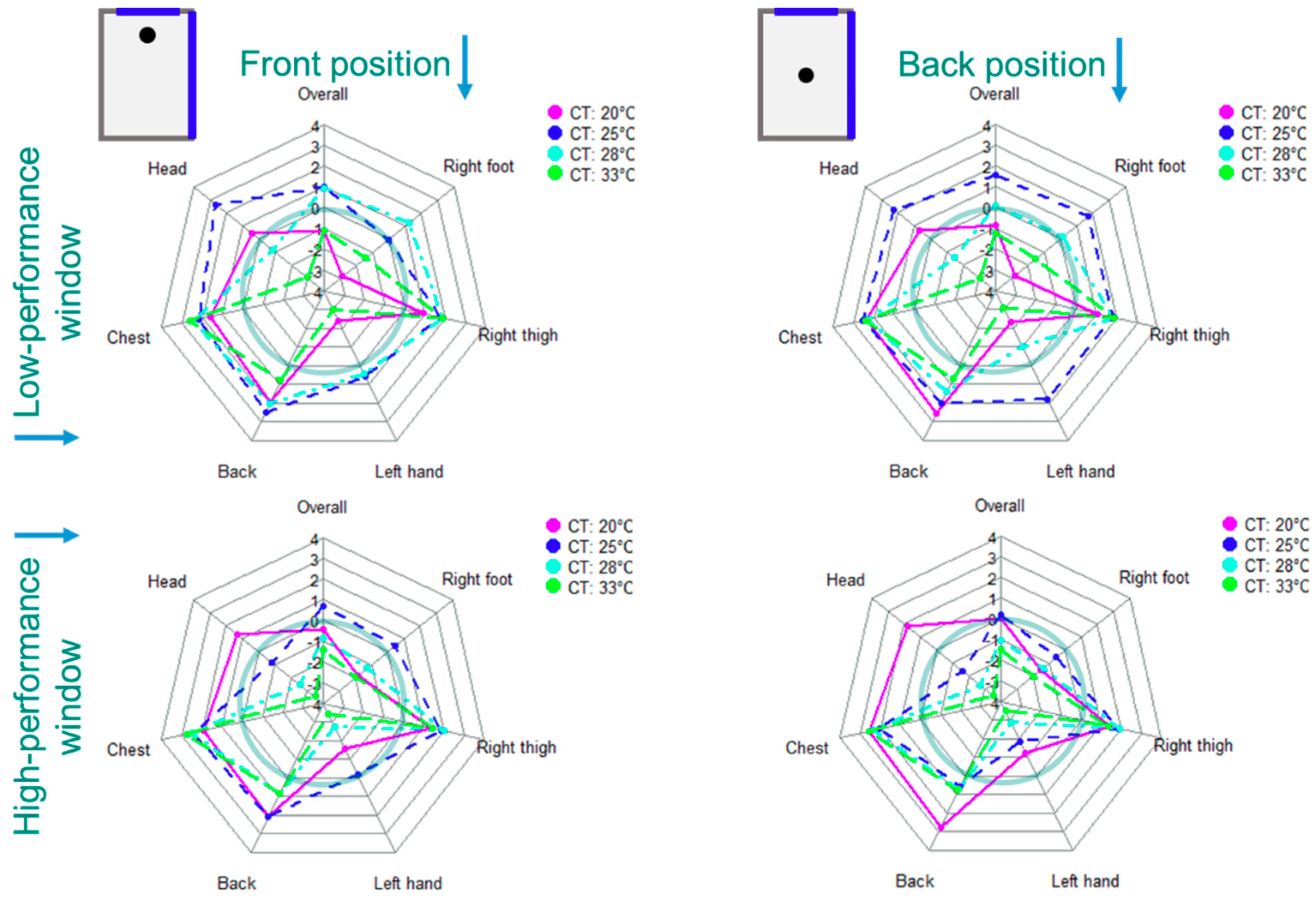
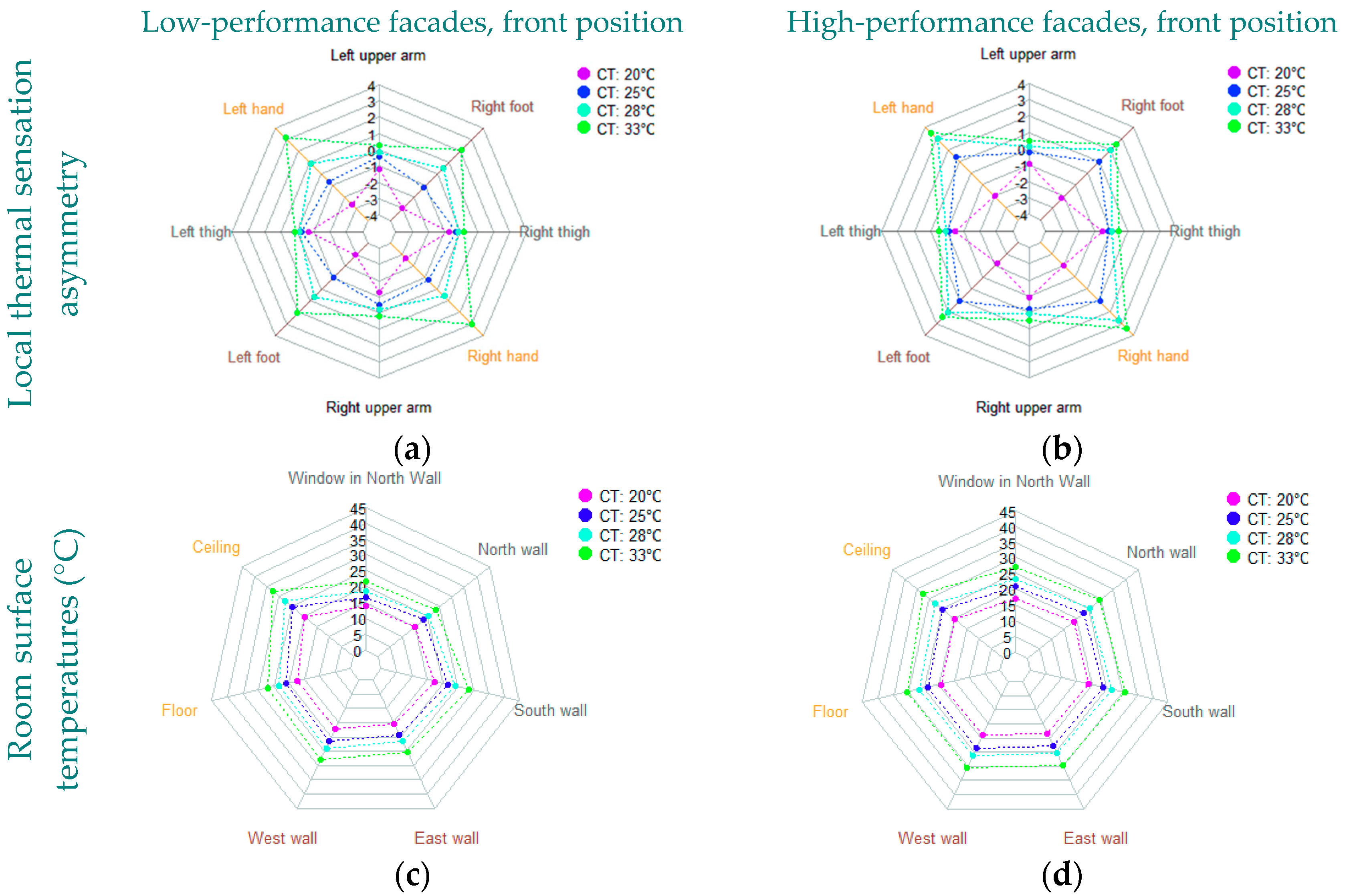
| Pipe Spacing (Center to Center) | Pipe Outside Diameter | Pipe Wall Thickness | Pipe Wall Thermal Conductivity |
|---|---|---|---|
| [m] | [m] | [m] | [W/(m·K)] |
| 0.025 | 0.005 | 0.001 | 0.35 |
| Without Renovation (Reference Building) | Partly Renovation (EnEV 2016) | Partly Renovation (Passive House) | Ambitious Renovation (EnEV 2016) | Ambitious Renovation (Passive House) | |
|---|---|---|---|---|---|
| Infiltration rate [1/h] | 0.5 | 0.2 | 0.1 | 0.1 | 0.05 |
| Without Renovation (Reference Building) | Partial Renovation (EnEV 2016) | Partial Renovation (Passive House) | Ambitious Renovation (EnEV 2016) | Ambitious Renovation (Passive House) | Heat Capacity | |
|---|---|---|---|---|---|---|
| Roof | 0.6 | 0.6 | 0.6 | 0.2 | 0.11 | 1.25 |
| Ceiling | 0.8 | 0.8 | 0.8 | 0.32 | 0.12 | 0.83 |
| Floor | 1.0 | 1.0 | 1.0 | 0.32 | 0.23 | 1.05 |
| External Wall | 1.4 | 0.25 | 0.14 | 0.25 | 0.14 | 0.77 |
| Window | 2.83 | 1.26 | 0.89 | 1.26 | 0.89 | - |
© 2019 by the authors. Licensee MDPI, Basel, Switzerland. This article is an open access article distributed under the terms and conditions of the Creative Commons Attribution (CC BY) license (http://creativecommons.org/licenses/by/4.0/).
Share and Cite
Safizadeh, M.R.; Watly, L.; Wagner, A. Evaluation of Radiant Heating Ceiling Based on Energy and Thermal Comfort Criteria, Part II: A Numerical Study. Energies 2019, 12, 3437. https://doi.org/10.3390/en12183437
Safizadeh MR, Watly L, Wagner A. Evaluation of Radiant Heating Ceiling Based on Energy and Thermal Comfort Criteria, Part II: A Numerical Study. Energies. 2019; 12(18):3437. https://doi.org/10.3390/en12183437
Chicago/Turabian StyleSafizadeh, M. Reza, Lukasz Watly, and Andreas Wagner. 2019. "Evaluation of Radiant Heating Ceiling Based on Energy and Thermal Comfort Criteria, Part II: A Numerical Study" Energies 12, no. 18: 3437. https://doi.org/10.3390/en12183437
APA StyleSafizadeh, M. R., Watly, L., & Wagner, A. (2019). Evaluation of Radiant Heating Ceiling Based on Energy and Thermal Comfort Criteria, Part II: A Numerical Study. Energies, 12(18), 3437. https://doi.org/10.3390/en12183437





